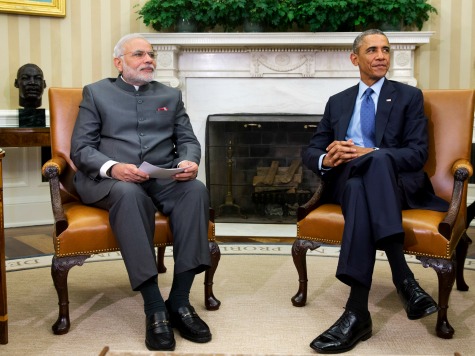
Despite a noticeably cool reception at the White House, everywhere else India’s new Prime Minister Narendra Modi went on his five day visit to the United States he was treated more like a pop star than the self-effacing 63-year old devout Hindu that he is.
More than 19,000 adoring fans, many of whom travelled from Indian communities throughout the United States and Canada just for the chance to see Modi, crammed into New York City’s iconic Madison Square Garden on Sunday for a rally that celebrated his election to lead the world’s largest democracy and served as a coming out party for America’s increasingly prosperous and influential Indian community.
That Modi’s visit focused more on cementing ties with the Indian-American community than it did trying to warm relations with an Obama Administration the new Indian leader distrusts for its shabby treatment of him prior to his election as Prime Minister last May is only too easy to comprehend. Indian-Americans are among the most accomplished, successful, and best educated immigrant communities in the United States. The average median household income for Indian-American families is roughly $90,000 per year, nearly twice the national average. Indian-Americans are far more likely to graduate from college than any other immigrant group, even other Asian immigrant groups. In short, in Narendra Modi, many Indian-Americans say they have an Indian leader who is a positive reflection of their own success and values.
Both Indian and U.S. officials had hoped that the long planned trip would help the world’s two largest democracies put past problems behind them by agreeing to a series of infrastructure and security cooperation agreements that might serve as templates for expanded ventures in the future.
Four of Modi’s five days in the U.S. were spent in New York, where in addition to sweeping America’s Indian-diaspora community off its feet, he addressed the United Nations General Assembly, had numerous meetings with leading U.S. industrialists as well as Bill Clinton and former New York mayor Michael Bloomberg, all while refusing to participate in last week’s much-hyped UN climate change conference.
Before leaving for home, Modi met President Obama at the White House for a working dinner which followed a two hour meeting in the Oval Office. One measure of how ties between the two countries remain raw was that the White House visit ended without the usual joint appearance that routinely follows such meetings.
Unlike recent Modi meetings with leaders of Japan and China which ended with the fanfare of huge bilateral trade deals ($35 billion worth of infrastructure projects in the case of Japan and nearly $100 billion of new contracts with China), the Indian leader left the United States without any big-ticket deals to trumpet. Modi refused to accede to American requests to open up its domestic agriculture market to more international competition, which prevented them from entering a trade agreement at the World Trade Organization.
The two global powers did agree to establish closer intelligence, defense, and national security ties, but there were no breakthroughs on disagreements such as India’s commercial nuclear power program that have hobbled relations in recent years. Speaking Tuesday before U.S. and Indian business leaders in Washington, Prime Minister Modi repeated his often stated goal of inspiring confidence in India’s economic potential to foreign and diaspora investors by promising to improve India’s business climate by cutting the country’s notorious red tape and regulations and helping to develop a 21st century Indian infrastructure.
China’s rise and the shift that portends for Asia’s balance of power should be bringing the U.S. and India closer together more easily than it seems to have. Despite the advantage of using India as a democratic bulwark against an authoritarian and increasingly hostile China, and Modi’s commitment to invest hundreds of billions of dollars over the coming decade into modernizing India’s military, relations between the two countries remain chilly.
The working dinner for 20 people that President Obama hosted for Modi Tuesday evening was downright spartan in contrast to the lavishly opulent $570,000 state dinner that Mr. Obama held for Modi’s predecessor, Manmohan Singh, in November 2009. While Mr. Modi was seated before an empty plate and glass of warm water to accommodate his observance of the nine-day Hindu fast-festival of Navrati, President Obama feasted on an avocado and goat cheese salad, crisped halibut and basmati rice, washed down with a California chardonnay and all topped off with a pumpkin crème brûlée.

COMMENTS
Please let us know if you're having issues with commenting.